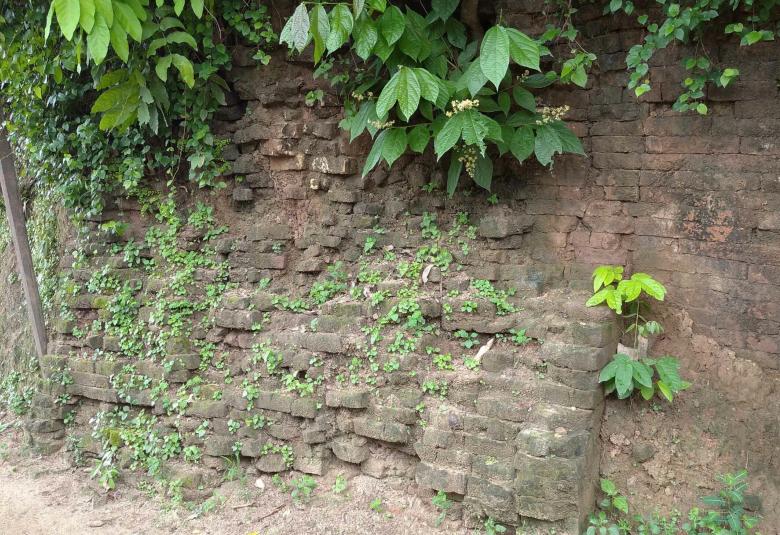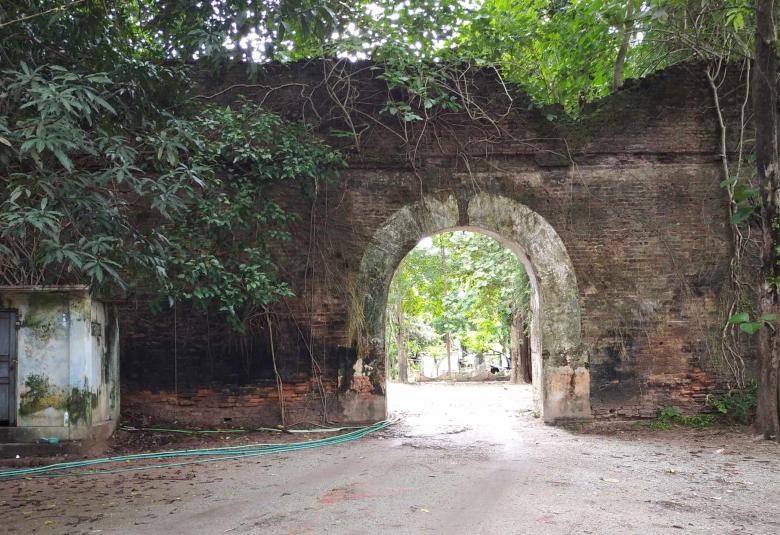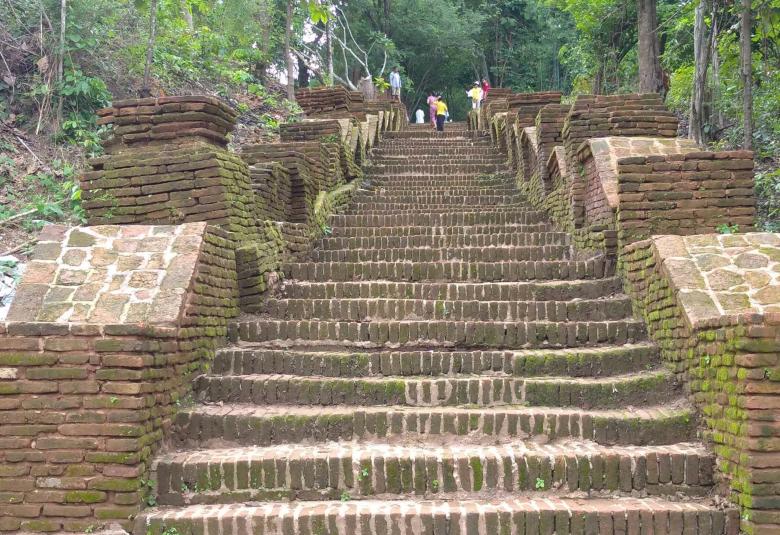Ancient Ketumati City established by Toungoo King Mingyi Nyo (1485-1530 AD) was famous as Toungoo. Before establishment of Ketumati, Toungoonge, Toungoogyi, Myawady and Dwarawady cities were built. After moving the city to different places, Ketumati was established in 1510.
Ancient Ketumati is located in Toungoo Township, 283 kilometres from Yangon along motor road and 267 kilometres along railroad. The ancient city is not far from Yangon-Mandalay highway and railroad. The land of ancient city is slightly higher than the land outside the walls.
Ketumati in the history
Thawungyi and Thawunnge brothers who started Ketumati Toungoo Dynasty established Toungoonge in 1278 AD and Toungoogyi in 1279 AD. Thawungyi became king in Toungoogyi. King Mingyi Nyo ascended onto the throne as 29th king of Toungoogyi in 1485 AD with Maha Thiri Zeyathu title and moved to Myawady City in 1486. The royal palace was moved again to Dwarawady City in 1491 AD.
King Min Khaung II (1481-1502 AD) reigned to Inwa City as contemporary of King Mingyi Nyo in Dwarawady City. Due to uprising in Inwa, people left Inwa City and took shelter of King Mingyi Nyo. As such, Dwarawady City possessed larger troops and strengths. As the area of Dwarawady City was not enough for increasing population, King Mingyi Nyo established new royal palace Ketumati in 1510 AD in the plain upstream of Dwarawady City and west of Paunglaung River.
In consulting with wise monks and laypersons, King Mingyi Nyo named the new royal palace as Ketumati in line with advice of Ceylon Sayadaw, Lawkottara Sayadaw and Taungnyo Pazin Kyetphataing Sayadaw. The royal palace was assumed as unrivalled palace. By reviewing a beehive at the city gate, fortune tellers said a large number of people would take shelter at the city, according to Twinthin History.
Till today, a lotus lake named four-island royal lake was dug in Ketumati City. (Four islands were Sabei, Hngetpyaw, Ohn and Leinmaw.)
Sayagyi U Chan Mya wrote that although the place of royal palace of King Mingyi Nyo could not be pointed in Ketumati City, an old palace was found in Mann Ward. So, it can be assumed the name Min Ward might be changed to Mann Ward. King Minye Kyawhtin with title of Minye Thihathu rebuilt new Toungoo royal palace in Toungoo in 962 ME and the place of royal palace was moved to the north-westward. It covered the area from U Thumana monastery to the government school.
Ketumati Royal Palace
Original Ketumati City was 700 tars from the east to the west and 1,000 tars from the south to the north. It was built on full moon day of Tazaungmone, 872 ME. At the same time, stakes were driven for construction of Mahayan golden monastery at northeast corner of the city.
Each wall side of the city consisted of five gates and five ordination halls. Each gate was built with a turret, and ordination halls were constructed outside Kyonhteik road by posting stone posts.
Manaung gate and KyunU ordination hall, Pagyi gate and Sitke ordination hall, Aungnan gate and Pyatthat ordination hall, Tagaung gate and Hsinbyu ordination hall and Kyaukyin gate and Gamani ordination hall were located in the eastern wall of the city, Thityin gate and KanU ordination hall, Pawrithat gate and Wasogon ordination hall, Sin gate and Karma ordination hall, Sityin gate and Pankyetyon ordination hall and Kalay gate and Kyethmyar ordination hall in the west, Ponnyet gate and Maha Pyetkhama ordination hall, Kalar gate and Theindawhla ordination hall, Kyarhmon gate and Daingpwe ordination hall, Linthet gate and Sokkatay ordination and Kyaeni gate and Shwekyetyet ordination hall in the south and Myawady gate and Sakar ordination hall, Tharapa gate and Gugyi ordination hall, Mawkun gate and Kyaungdawgyi ordination hall, Yanaungmyin gate and Yintaw ordination hall and Kyethmyar gate and Khweye ordination hall in the north.
King Mingyi Nyo built Manaung Ceti at northeast corner of the city, Tharamyinzu Ceti at southeast corner, Myatheintan Ceti at southwest corner and Myinzuthara Ceti at northwest corner.
Moreover, nine cities were also established around Ketumati-Toungoo—Weluwady (Kyakhatwayan City-now Swa), Danyawady (Toungoogyi, west of Khabaung Creek), Aungchawady (west of Khabaung Creek), Dwarawady (Myogyi Lawkottara), Arthawady (now Myosoe), Zeyawady (ancient Zeyawady City), Thelawady (Kyaukmaw City between Shwegyin and Kyaukkyi), Philawady (Kyaungpya City between Kyaukkyi and Mone ) and Ketumati (now Toungoo).
Kyuntaw, Yepok, Oh and Htini mounds were made in the south of Toungoo and Kyetsha, Nyaung, Tharaphi, Pyatthat and Kantwin mounds in the north.
Location of Kyuntaw mound is assumed as the site near Kyeni gate in south of Toungoo. Yepok mound is located in south of Toungoo. Oh mound is situated in Ngwehlan Ohkon Ward in Toungoo. Htini mound takes a position on Yangon-Mandalay highway.
Walls, moats and royal lake
The records mentioned that more than 48,000 people were deployed in building the four walls of Ketumati City with the use of 38,707,200 pieces of bricks and 10,680,000 pots of plaster. Plaster pot was one cubic elbow, so it contained 3.37 cubic feet of plaster.
The wall was 12 elbows high, four elbows deep and seven elbows wide on the top surface. According to the current measurements, the wall of Ketumati City was 17 feet and 10 inches high and 10 feet and five inches wide. Along the walls were built of 7,200 merlons, 84 Hmawyuns and 24 turrets. A total of 2,012,460 toddy palm plants were grown outside the walls. Some parts of southern wall were destroyed in construction of Yangon-Mandalay railroad.
Parts of the wall collapsed at some gates to ancient city. In measurement, the brick was 15.5 inches long and nine inches thick.
A three elbows deep and three tars wide silt moat was dug, two tars to the wall. Such silt moat was surrounded by 12 elbows deep and 25 tars wide water moat. Water in the moat was seven elbows deep. Till today, the eastern moat is filled with water for the whole year. Three remaining moats are filled with water in monsoon but nothing in cold and summer seasons. The silt moat already disappeared.
King Mingyi Nyo renovated the lotus lake which had been existing before establishment of Ketumati with four islands namely Sabei, Hngetpyaw, Ohn and Leinmaw islands. Hngetpyaw island and Ohn island were connected with a wooden bridge.
Three significant sites in ancient Ketumati City
Among significant sites, Yodayapauk was a moat drain, northeast of Toungoo to drain out water from the moat to Sittoung River. Historian writer Thaung Ketu (Dr Mya Thaung) explained such drain was built by Phra Naresun, Yodaya King who attacked Toungoo. The drain was 108 feet long, located on Yangon-Mandalay Highway.
Kyaukyin Gate was destroyed by British in 1864 to build Myolay Fort which was a historic building of ancient Ketumati City.
While in Dwarawady City, King Mingyi Nyo visited Myatsaw Nyinaung Pagoda along an over 700 feet long way for paying homage. Such way was paved with bricks. A 200 feet long part of the way was renovated to create a pleasant, historic site for visitors.
King Mingyi Nyo passed away on 5th waxing of Nadaw, 892 ME after taking power for 46 years. The king was succeeded by son Tabinshwehti who moved the royal palace to Hanthawady after residing in Ketumati till 902 ME.
Translated by Than Tun Aung
References:
New Twinthin Maha History (U Tun Nyo)
Brief Toungoo History (U Chan Mya)
Ancient cities of Myanmar (U Aung Myint)






